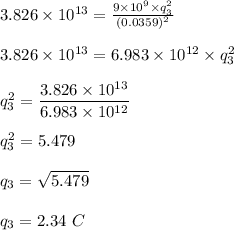
Two particles, one with charge -2.93 ?C and one with charge 1.87 ?C, are 3.59 centimeters apart. What is the magnitude of the force that one particle exerts on the other? B. Two new particles, which have identical positive charge q3, are placed the same 3.59 centimeters apart, and the force between them is measured to be the same as that between the original particles. What is q3?

Answers: 2


Other questions on the subject: Physics

Physics, 21.06.2019 18:30, mariatorres7
Which of these describe conduction transfer of heat between two objects that are touching transfer of heat by the actual movement of war matter the process in which energy is imitated by one of the object transmitted through space and absorbed by another a process in which energy is released by the molecules breaking apart
Answers: 1

Physics, 21.06.2019 21:00, victoriazh2005
Apulley with a mechanical advantage of 5 will require you to pull times the amount of rope. a. 1/5 b. 5 c. 10 d. 15
Answers: 2

Physics, 22.06.2019 01:00, muhammadcorley123456
4. who was the first one to measure the speed of light and conclude that it is finite? 5. who was the first philosopher who thought the speed of light is finite? 13. what is the speed of light numerically? 14. give an example of something moving faster than light 15. give an example for some particles or waves that
Answers: 1

Physics, 22.06.2019 01:00, yedida
What is the relationship between atmospheric pressure and the density of gas particles in an area of increasing pressure? (2 points) as air pressure in an area increases, the density of the gas particles in that area decreases. as air pressure in an area increases, the density of the gas particles in that area increases. as air pressure in an area increases, the density of the gas particles in that area remains constant. as air pressure in an area increases, the density of the gas particles in that area increases and decreases in an alternating pattern. 3. which of the following correctly describes a way in which earth's atmosphere interacts with the geosphere? (2 points) it contains gases that living organisms breathe. it contains gases that trap incoming solar radiation. it provides a medium for cycles that provide nutrients to living organisms. it provides a medium for water to move between earth's surface and the air. 4. which of the following is considered a drawback to using wind energy as a source of power? (2 points) wind energy is nonrenewable. wind energy produces large amounts of air pollution. wind turbines can kill birds that fly through the rotors. wind turbines are built too close to major population centers. 5. a meteorologist predicts that the weather in a region will soon change from clear skies to probable thunderstorms. prior to making this prediction, what did the meteorologist most likely observe on a barometer? (2 points) the barometer fell slightly. the barometer fell substantially. the barometer rose slightly. the barometer rose substantially. 6. which of the following do meteorologists not typically use weather balloons to record? (2 points) atmospheric pressure cloud types humidity temperature 7. during which step in the can crush lab did water vapor force air from the can? (2 points) the can was filled nearly to the top with water. the can was placed on the hot stove top burner for several minutes. the can was removed from the hot stove top burner. the can was placed upside-down in the water-filled pan.
Answers: 3
You know the right answer?
Two particles, one with charge -2.93 ?C and one with charge 1.87 ?C, are 3.59 centimeters apart. Wha...
Questions in other subjects:


Social Studies, 27.06.2019 03:00

Chemistry, 27.06.2019 03:00

Mathematics, 27.06.2019 03:00

Mathematics, 27.06.2019 03:00

Advanced Placement (AP), 27.06.2019 03:00







 is the coulomb's constant.
is the coulomb's constant.
 .
.




